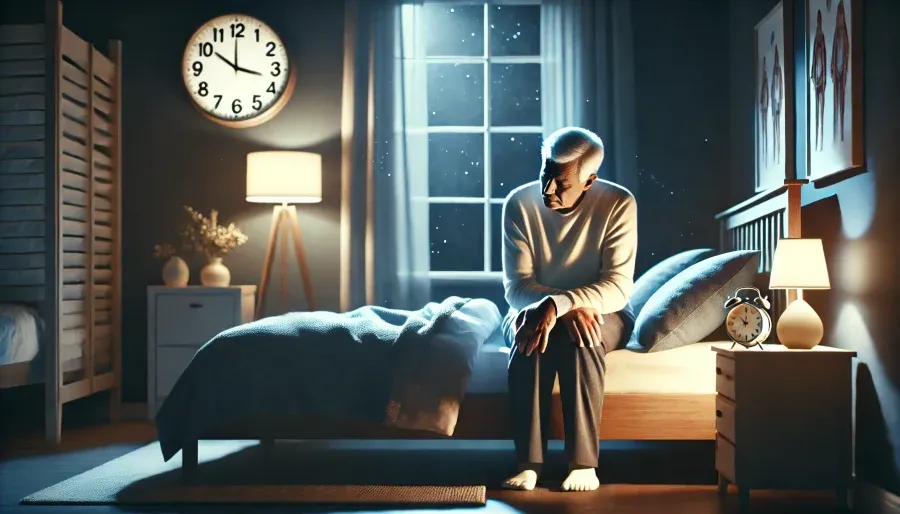1. Introduction:
As we age, our bodies undergo various changes, and joint pain becomes a common complaint for many elderly individuals. While joint discomfort can occur at any time of day, joint pain at night often feels worse and more disruptive. This can interfere with one of the most vital aspects of health: sleep. Rest is essential for the body to heal and regenerate, but when pain flares up during the night, it leads to restless nights, frequent awakenings, and difficulty falling back asleep. Over time, poor sleep can affect not only physical well-being but also mental health, increasing feelings of fatigue, irritability, and even depression.
Several factors contribute to joint pain, including natural wear and tear, chronic conditions like osteoarthritis, or inflammatory disorders such as rheumatoid arthritis. Inactivity, prolonged periods of lying down, and stiffness that sets in overnight may exacerbate the discomfort. The weight of blankets or pressure from certain sleep positions can also increase joint stress, especially on the hips, knees, and shoulders.
For elderly individuals, addressing nighttime joint pain is particularly important because it can become a vicious cycle: pain leads to poor sleep, which in turn makes the body less equipped to handle pain the next day. This blog will explore the common causes of joint pain at night in the elderly, how it affects sleep quality, and practical strategies for managing it so that older adults can enjoy a more restful and pain-free night’s sleep.
2. Common Causes of Joint Pain at Night
For elderly individuals, joint pain at night is a frequent and frustrating issue, often stemming from underlying health conditions that are more prevalent with age. Let’s explore the most common causes of this discomfort and why it tends to intensify during the night.
Osteoarthritis
Osteoarthritis is the leading cause of joint pain at night among elderly individuals. This degenerative condition occurs when the protective cartilage that cushions the ends of bones wears down over time, leading to stiffness, swelling, and pain in the joints. During the day, joint movement may help distribute fluids that lubricate the joints, making the pain less noticeable. However, at night, when the joints are at rest, stiffness sets in, and inflammation can increase, leading to more pronounced discomfort. Osteoarthritis commonly affects weight-bearing joints like the hips and knees, making it difficult for individuals to find a comfortable sleeping position.
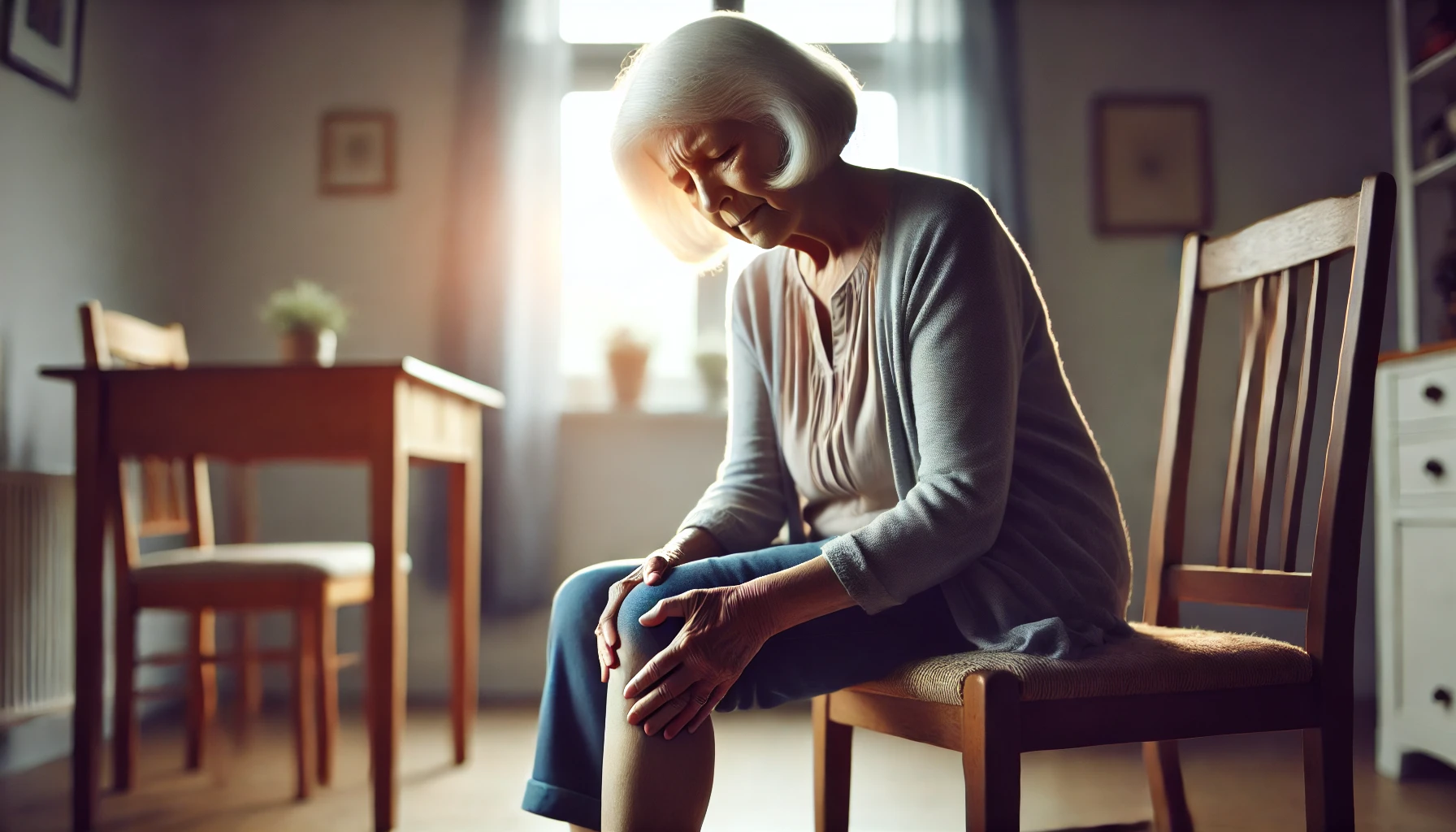
Rheumatoid Arthritis
Rheumatoid arthritis is an autoimmune condition where the body’s immune system mistakenly attacks its own joint tissues, causing chronic inflammation. This inflammation can worsen at night due to changes in body temperature, circulation, and cortisol levels, all of which tend to fluctuate in the evening. As the body winds down for sleep, these changes can trigger joint pain at night, particularly in the hands, wrists, and feet. The stiffness and swelling associated with rheumatoid arthritis can make getting comfortable in bed a challenge, leading to frequent wakefulness.
Bursitis and Tendinitis
Bursitis and tendinitis are conditions involving inflammation of the soft tissues surrounding the joints. Bursitis affects the small fluid-filled sacs (bursae) that cushion the bones, tendons, and muscles near the joints, while tendinitis refers to inflammation of the tendons themselves. These conditions are often aggravated by overuse or repetitive motion during the day. At night, the pain from bursitis or tendinitis may intensify because the affected areas remain static for extended periods, causing stiffness and discomfort. Commonly affected joints include the shoulders, elbows, hips, and knees.
Gout
Gout is a type of arthritis caused by the accumulation of uric acid crystals in the joints. It typically results in sudden, severe pain, redness, and swelling, most often in the big toe. Gout attacks can happen at any time, but they are especially likely to occur during the night, possibly due to lower body temperature and dehydration during sleep. The sharp, intense pain associated with gout can make sleep nearly impossible until the flare subsides.
Inactivity and Poor Circulation
Lack of movement during sleep can exacerbate joint pain at night. In elderly individuals, poor circulation and reduced flexibility may cause stiffness to build up in the joints as they lie still for extended periods. This leads to increased discomfort and a harder time falling back asleep after waking.
Understanding the common causes of joint pain at night—from osteoarthritis to gout—can help elderly individuals identify why they may experience increased discomfort during sleep. Each condition has unique triggers, but managing inflammation, improving circulation, and adopting healthy sleep habits can provide significant relief and improve overall quality of life.
3. Impact of Nighttime Joint Pain on Sleep
When joint pain at night interrupts sleep, it can lead to a range of negative physical and mental health effects. For elderly individuals, restful sleep is especially crucial for overall well-being and quality of life. Let’s explore how nighttime joint pain affects sleep quality and what this disruption can mean for long-term health.
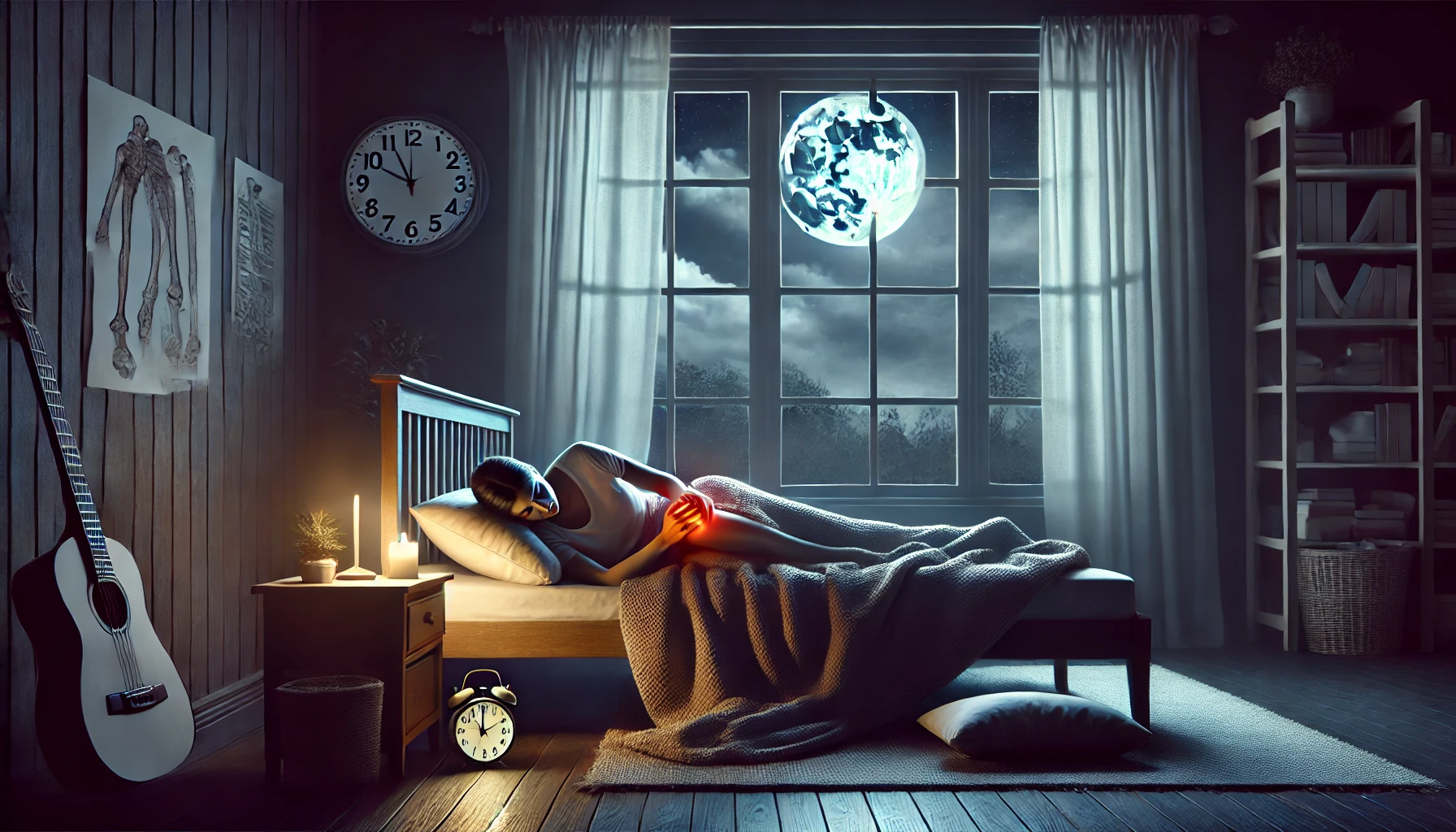
Sleep Disruption and Restlessness
Joint pain at night often causes frequent awakenings. Pain can wake individuals from sleep multiple times during the night, resulting in fragmented rest. Once awakened, it may be difficult to find a comfortable position, leading to tossing and turning. This restlessness not only reduces the total amount of sleep but also interferes with the deeper, restorative stages of sleep, such as REM and deep sleep, which are crucial for both physical healing and cognitive function.
Sleep Deprivation and Its Effects
When pain consistently interrupts sleep, elderly individuals may experience sleep deprivation over time. This lack of rest can have far-reaching effects on physical and mental health. Chronic sleep deprivation can exacerbate joint pain at night, creating a vicious cycle where pain worsens due to insufficient rest, and poor sleep leads to more inflammation and reduced pain tolerance. Additionally, ongoing sleep disruption can impair cognitive abilities, affect mood, and weaken the immune system. For elderly individuals, these effects may contribute to increased risks of depression, anxiety, and cognitive decline, as well as slower recovery from illness or injury.
Impact on Daytime Functioning
Poor sleep quality due to joint pain at night can carry over into the day, leading to fatigue, reduced energy, and decreased ability to engage in daily activities. This daytime fatigue can make it difficult for elderly individuals to stay active, which is essential for maintaining joint health. A sedentary lifestyle may lead to further joint stiffness and discomfort, worsening the pain over time.
In summary, joint pain at night severely disrupts sleep quality, leading to a range of negative health outcomes. Managing nighttime pain effectively is essential for promoting better sleep and overall health in elderly individuals.
4. Practical Tips for Managing Joint Pain at Night
Effectively managing joint pain at night is crucial for improving sleep quality and overall well-being, particularly for elderly individuals. Simple lifestyle adjustments, targeted therapies, and environmental changes can help reduce nighttime discomfort and lead to more restful sleep. Let’s explore some practical strategies that can make a big difference.
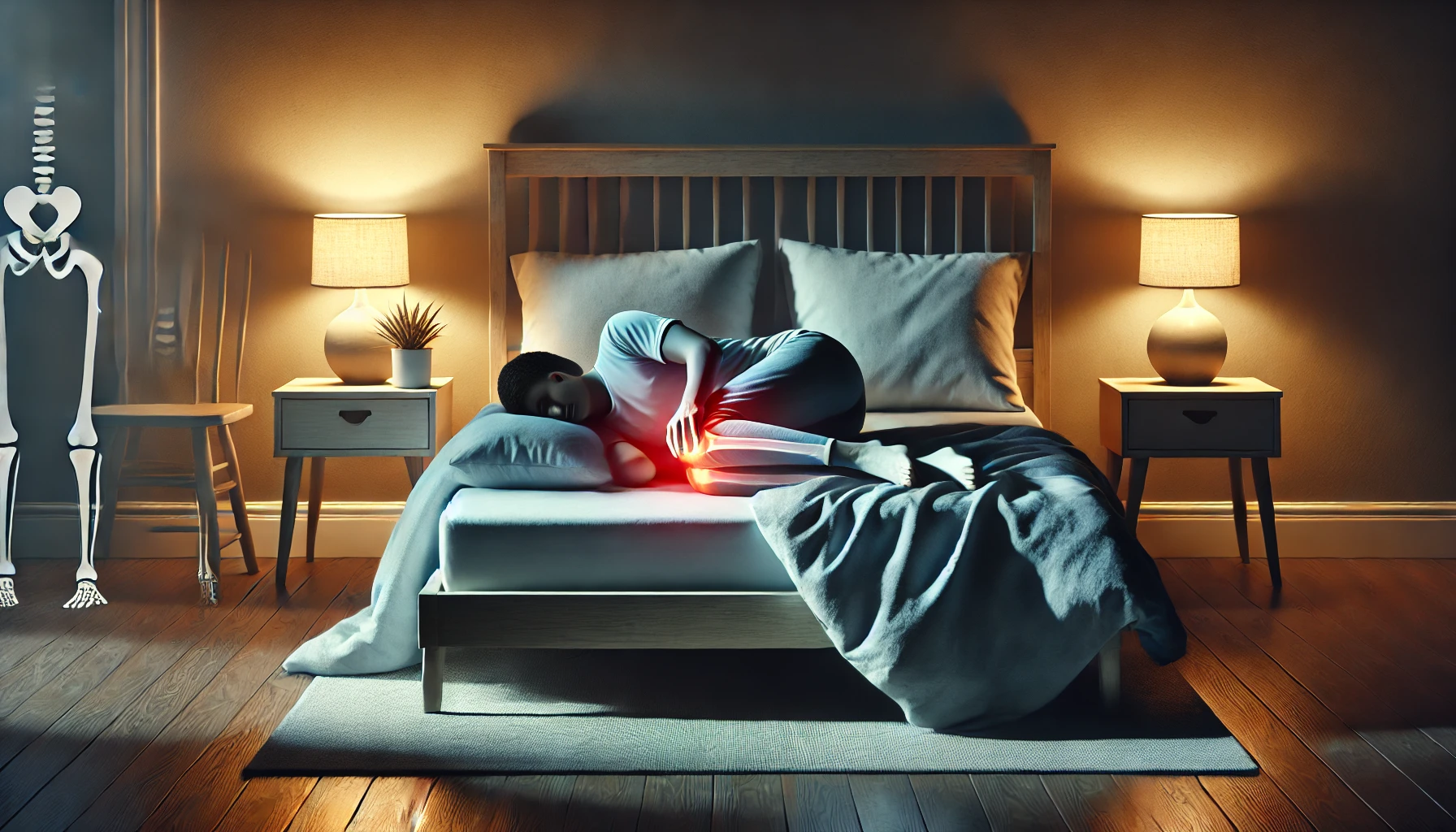
Sleep Position Adjustments
One of the simplest ways to alleviate joint pain at night is by adjusting your sleep position. Lying in certain positions can place unnecessary pressure on painful joints, increasing discomfort. For those with hip or knee pain, sleeping on the back or side with a pillow between the knees can help align the spine and reduce strain on the joints. If shoulder pain is a problem, sleeping on the unaffected side or on the back with a supportive pillow can relieve pressure. Experimenting with different sleep positions and using supportive pillows or wedges can provide much-needed relief for sore joints.
Heat and Cold Therapy
Applying heat or cold therapy before bed is a highly effective way to manage joint pain at night. Heat therapy, such as using a warm bath, a heating pad, or a hot water bottle, can help relax tight muscles, improve circulation, and soothe aching joints. This can be particularly beneficial for those suffering from osteoarthritis or rheumatoid arthritis. On the other hand, cold therapy, such as using ice packs, is excellent for reducing inflammation and numbing sharp pain, making it a useful option for conditions like bursitis, tendinitis, or gout. Incorporating heat or cold treatments into your bedtime routine can prevent pain flare-ups as you settle down to sleep.
Gentle Stretching and Exercise
Engaging in gentle stretching exercises before bedtime can improve flexibility, reduce stiffness, and ease joint pain at night. Stretching helps loosen tight muscles and joints, making it easier to stay comfortable throughout the night. Focus on slow, gentle movements that target the affected joints, such as hip stretches, shoulder rolls, or knee bends. In addition to stretching, regular low-impact exercises like swimming, walking, or yoga can strengthen the muscles surrounding the joints and enhance flexibility. This helps reduce pressure on the joints and prevents stiffness from setting in overnight.
Mattress and Bedding Considerations
A good mattress and proper bedding can make a significant difference in managing joint pain at night. A mattress that is too firm or too soft may fail to support your body properly, leading to increased joint pressure and discomfort. Look for a medium-firm mattress that provides both support and cushioning for your joints. Memory foam mattresses or toppers can be particularly helpful because they contour to your body’s shape and reduce pressure points. Additionally, using supportive pillows to cushion painful joints can help you maintain a comfortable sleeping position and reduce nighttime pain. Investing in high-quality bedding designed to support joint health is a key factor in minimizing pain and improving sleep.
Over-the-Counter Pain Relief
For those experiencing mild to moderate joint pain at night, over-the-counter pain relievers like acetaminophen or nonsteroidal anti-inflammatory drugs (NSAIDs) such as ibuprofen can offer temporary relief. These medications help reduce inflammation and dull the pain, making it easier to fall asleep and stay asleep. However, it’s important to use these medications responsibly and consult a healthcare provider before incorporating them into your routine, especially for long-term use.
Hydration and Diet
Staying hydrated is essential for joint health, especially for those prone to gout flare-ups, which are often triggered by dehydration. Drinking plenty of water throughout the day can help prevent these painful episodes. Additionally, a balanced diet rich in anti-inflammatory foods, such as fruits, vegetables, and omega-3 fatty acids, can help reduce inflammation and support joint health, potentially lessening joint pain at night.
By making simple adjustments to sleep positions, using heat and cold therapies, stretching, and investing in supportive bedding, elderly individuals can significantly reduce joint pain at night and improve overall sleep quality.
5. When to Seek Medical Advice
While many elderly individuals can manage joint pain at night with at-home remedies and lifestyle adjustments, there are times when medical intervention becomes necessary. Understanding when to seek help from a healthcare provider is crucial, as persistent or worsening pain may signal a more serious underlying condition. Let’s explore key signs that indicate it’s time to consult a doctor.
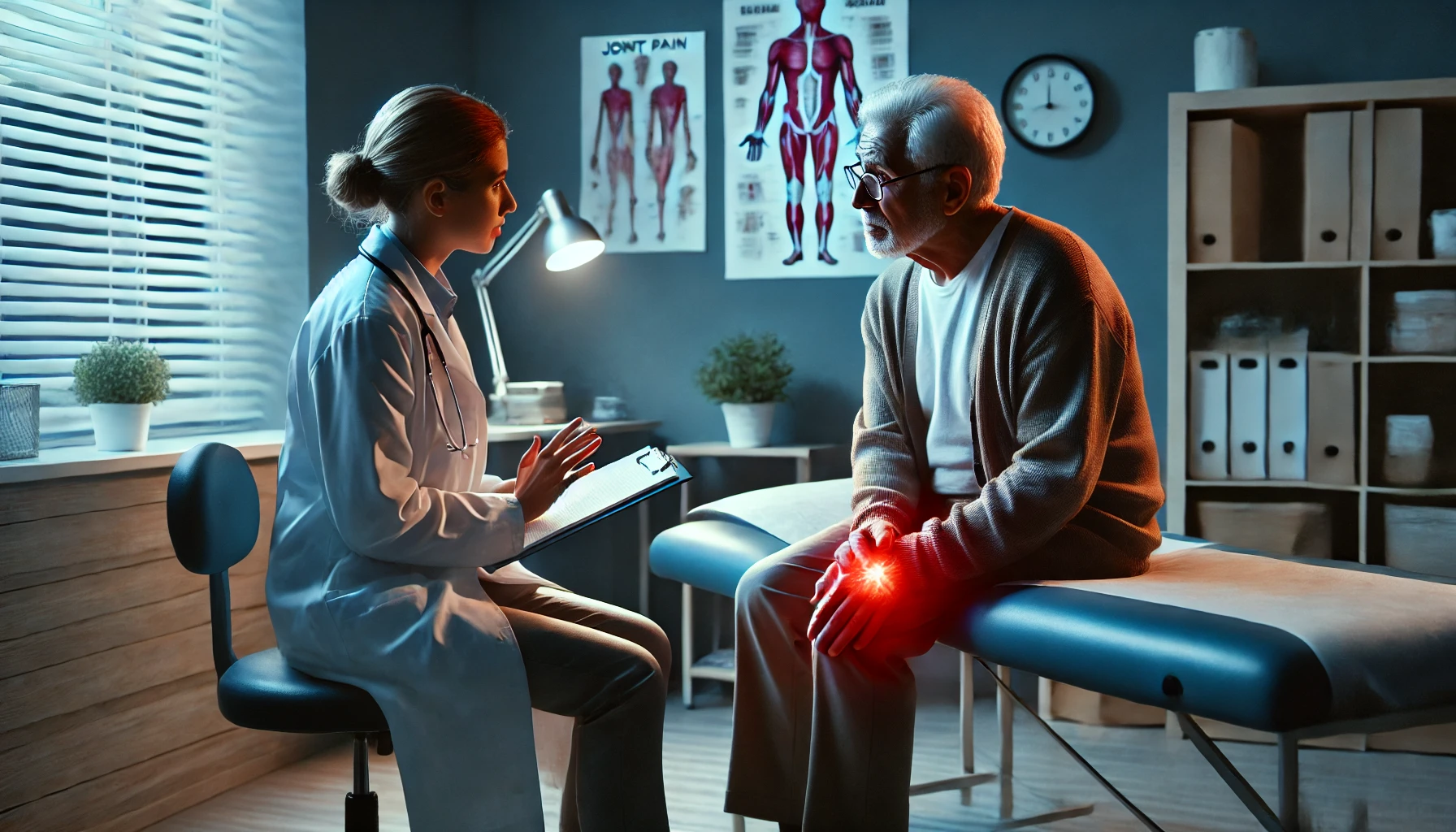
Persistent or Worsening Pain
If joint pain at night becomes progressively worse, despite attempts to manage it with over-the-counter remedies, heat and cold therapy, or changes to sleep positioning, it may be time to seek medical advice. Pain that does not respond to home treatments could indicate a more severe form of arthritis or an issue with joint degeneration that requires medical intervention. A doctor can evaluate the joint through imaging tests like X-rays or MRIs to determine whether there has been significant cartilage damage, bone loss, or another structural problem.
Joint Swelling and Redness
Sudden or persistent swelling and redness in the joints, especially if accompanied by warmth around the area, is a red flag that warrants medical attention. These symptoms could be indicative of an infection, such as septic arthritis, or an inflammatory condition like rheumatoid arthritis or gout. If left untreated, joint infections can lead to permanent joint damage and other health complications. Therefore, if swelling and redness occur alongside joint pain at night, it’s essential to seek medical advice promptly.
Loss of Joint Function
In some cases, joint pain at night may be accompanied by a loss of mobility or function in the affected joint. If it becomes increasingly difficult to move the joint through its normal range of motion, or if there is significant stiffness or locking in the joint that doesn’t improve with rest, this could indicate serious joint deterioration. Loss of function could also be a sign of a torn ligament or tendon, which requires professional evaluation and possibly surgical intervention.
Pain Interfering with Daily Activities
When joint pain becomes severe enough that it disrupts not only sleep but also daily activities, such as walking, standing, or performing basic tasks, it’s a clear sign that medical help is needed. A healthcare provider can help determine whether stronger pain relief options, physical therapy, or even joint injections or surgery may be required to alleviate the discomfort and restore functionality.
Need for Prescription Medications
If over-the-counter medications fail to manage joint pain at night, a doctor can prescribe stronger anti-inflammatory drugs, pain relievers, or disease-modifying antirheumatic drugs (DMARDs) in cases of autoimmune conditions like rheumatoid arthritis. Injections of corticosteroids directly into the joint may also be recommended to reduce inflammation and pain in the short term.
Conclusion
Joint pain at night is a common issue for many elderly individuals, but it doesn't have to lead to sleepless nights and diminished quality of life. By understanding the underlying causes, such as osteoarthritis, rheumatoid arthritis, or even lifestyle factors like inactivity, you can begin to address the pain more effectively. Simple adjustments, like modifying sleep positions, using heat or cold therapies, and stretching, can go a long way in providing relief and making nighttime more comfortable. In addition, investing in a supportive mattress and pillows designed to ease joint pressure is a practical step toward reducing pain and improving sleep.
However, not all cases of joint pain can be managed at home. If the pain persists or worsens, or if it is accompanied by swelling, redness, or a loss of joint function, it’s important to consult a healthcare professional. Early medical intervention can prevent further joint deterioration and provide access to treatments like prescription medications, physical therapy, or joint injections that offer stronger, longer-lasting relief. Ultimately, by taking proactive steps and seeking medical advice when needed, elderly individuals can significantly reduce the impact of joint pain at night and regain control over their sleep and daily activities.
Good sleep is essential for overall health and well-being, especially as we age. Addressing nighttime joint pain head-on can improve not only sleep quality but also energy levels, mobility, and mood, contributing to a healthier, more active lifestyle.


